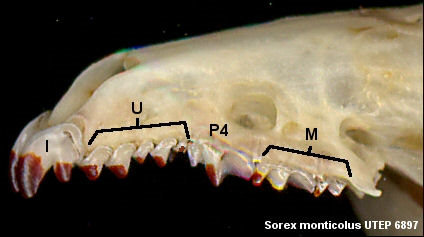Class Mammalia
Order Eulipotyphla
Family Soricidae
Cryptotis parva—Least Shrew // Notiosorex—Notiosorex Shrews // Sorex—Long-tailed Shrews
The Soricidae consists of several subfamilies, but only the Soricinae occur in the Americas (Hutterer 2005). Shrews are, for the most part, inhabitants of the arctic and northern temperate regions of the earth. Most species require relatively mesic ecological conditions. As a result, most habitat in the Southwest is in highlands where precipitation is greater than in the semiarid to arid lowlands, and most relationships are to the north. However, some species have adapted to moderately well developed grasslands, mostly to the east of our region. Another genus (Notiosorex) occurring in the Southwest is adapted to relatively arid conditions.
 Shrews are generally recognizable by their teeth, among other characters. The
upper and lower incisors are directed forward rather than being nearly vertical,
looking somewhat like the jaws of a pair of pliers. Behind the incisors are two or more
unicuspids, followed by a premolar (premolar 4) and three molars. The North American
species have reddish pigment on the tooth cusps, at least in the anterior dentition.
Other examples of dentition can be seen in the genus and species accounts.
Shrews are generally recognizable by their teeth, among other characters. The
upper and lower incisors are directed forward rather than being nearly vertical,
looking somewhat like the jaws of a pair of pliers. Behind the incisors are two or more
unicuspids, followed by a premolar (premolar 4) and three molars. The North American
species have reddish pigment on the tooth cusps, at least in the anterior dentition.
Other examples of dentition can be seen in the genus and species accounts.
Fig. 1. Lateral view of the anterior skull of Sorex monticolus. "I" = incisor, "U" = unicuspids, "P4" = fourth upper premolar, and "M" = molars.
Of several genera of shrews currently inhabiting North America, Sorex and Notiosorex are represented by two or more species in the Pleistocene of our region, while a third, Cryptotis, is represented by one species.
Literature.
Last Update: 22 Aug 2019 2010